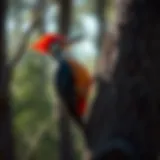Discover the Ecological Treasures of Norbeck Park


Intro
Nestled within a tapestry of rolling hills and lush greenery, Norbeck Memorial Park is not just a recreational getaway but a sanctuary of biodiversity and ecological wonders. It serves as a significant hub for the community, offering a blend of leisure and education for all ages. As we tread through the park's winding paths, we begin to uncover the intricate web of life and history that makes this park an invaluable treasure.
Our exploration will take us into the depths of woodland ecosystems, highlighting their importance not only to local wildlife but also to the global environment. We'll dive into the strategies that ensure sustainable management of these vital areas, revealing techniques that professionals can employ.
This article aims to paint a vivid picture of the park’s ecological significance while advocating for active engagement in conservation practices. By weaving these threads together, it becomes clear how Norbeck is more than merely a place to unwind; it’s a beacon for more conscientious living.
Understanding Woodland Ecosystems
The ecosystem within Norbeck Memorial Park is a great example of how forests contribute significantly to our well-being. Understanding these woodland ecosystems helps paint a clearer picture of why they matter.
Importance of Biodiversity in Forests
Biodiversity is the lifeblood of woodland ecosystems. Not only does it bolster the resilience of the ecosystem, but it also ensures that various species—plants, animals, and micro-organisms—can thrive together. In Norbeck, this rich diversity offers a unique living laboratory for ecologists and students alike to study interspecies relationships.
Did you know? Over 100 species of birds can be spotted during migration periods, making Norbeck a birdwatcher’s paradise. This varied avifauna highlights the importance of preserving such ecosystems, as each species plays a specific role in maintaining the balance.
Role of Forests in Climate Regulation
Forests are often dubbed the lungs of our planet, as they play a critical role in absorbing carbon dioxide and releasing oxygen. In Norbeck, the dense thickets act as carbon sinks, contributing significantly to climate regulation. Besides capturing carbon, they help maintain local climate conditions by regulating temperature and humidity.
Additionally, trees in the park help minimize soil erosion, improve water quality, and create a habitat for diverse wildlife. The interplay of these functions underscores the pressing need for sound forest management techniques.
Sustainable Forestry Practices
With the challenges of climate change and habitat loss, sustainable forestry practices become more crucial than ever. In Norbeck, sustainable practices can help maintain its ecological integrity while enabling the community to continue enjoying its resources.
Principles of Sustainable Forestry
Sustainable forestry is built on fundamental principles that aim for the long-term health of forest ecosystems. Key elements include:
- Maintaining biodiversity: Diversity ensures ecosystems remain resilient.
- Ecosystem service conservation: Protecting the services forests provide to humans and wildlife.
- Community engagement: Ensuring local voices have a say in forest management decisions.
Implementing these principles in Norbeck reflects not just on the park but serves as a blueprint for parks across the globe.
Case Studies of Successful Implementations
The successful management of forests doesn’t always occur without resistance. However, looking at successful models can be instructive. For example, areas involved in community forestry initiatives have seen marked improvement in both biodiversity and local livelihoods. Norbeck can draw lessons from practices implemented in places like the Yellowstone National Park, where partnerships with local stakeholders have driven conservation efforts.
"Community involvement is vital. The more people understand and participate in conservation, the better equipped we are to face ecological challenges."
— Representative, Norbeck Park Conservancy
Woodland Stewardship Techniques
Forest stewardship is about making informed decisions that benefit both the environment and the community. Norbeck Memorial Park employs various techniques aimed at ensuring its ecological health while fostering public enjoyment.
Forest Management Plans
A comprehensive forest management plan serves as a guiding star for ensuring that the park remains a biodiverse habitat. Regular assessments of tree health, understory vegetation, and wildlife populations help inform adaptive management practices. This constantly evolving plan allows for adjustments in response to unforeseen challenges.
Conservation Strategies
Effective conservation strategies within Norbeck often utilize community volunteers, educational programs, and outreach initiatives. Encouraging local participation helps nurture a collective sense of responsibility toward maintaining the park and its resources. Educational workshops on the importance of biodiversity and techniques for personal woodland stewardship can galvanize public interest and commitment.
Through these practices, Norbeck stands as a model for urban ecological sustainability, demonstrating how communities can sustainably manage natural resources.
Whether you’re an academic or a casual visitor, understanding these dynamics enriches any visit to Norbeck Memorial Park, making it clear that your engagement not only enhances your own experience but contributes to a larger ecological purpose.
Intro to Norbeck Memorial Park
Norbeck Memorial Park is not just any green space; it represents a thriving ecosystem that serves both ecological and community functions. This section provides a foundation for understanding the multiple layers of significance that the park offers. The importance of this sanctuary goes beyond its lush landscapes and tranquil trails. It encapsulates historical narratives, fosters biodiversity, and encourages recreational activities that replenish both body and spirit.
Visitors stepping into the park are greeted by a mosaic of natural beauty, supported by a keen dedication to the preservation of its landscapes. As rural sprawl continues to threaten natural habitats, Norbeck serves as a refuge for various species while simultaneously acting as a vital resource for local communities.
Location and Access
Nestled in the heart of the region, Norbeck Memorial Park boasts a strategic and convenient location that enhances its accessibility. Located just a stone's throw from major highways, reaching this natural haven is a breeze for both residents and tourists.


With towering trees and panoramic vistas, the park can be accessed via multiple entry points, ensuring that visitors can choose a route that best suits their needs. With well-maintained parking lots and marked trails, navigating through the park is both efficient and pleasant. Some local public transportation options also provide stops nearby, making it all the easier for nature enthusiasts to visit.
Historical Overview
The rich history of Norbeck Memorial Park adds layers of depth to the landscapes, making them more than just serene backdrops. Originally part of broader conservation efforts, the park has evolved into a land that reflects not just ecological significance but cultural memories as well.
In earlier days, Native American tribes used these lands for hunting and gathering, signifying a deep-rooted connection to the land. This historical context paves the way for understanding how present-day conservation practices align with traditional respect for nature.
As more settlers arrived, the region began to develop, yet plans for preservation were also initiated. The establishment of the park in the late 20th century marked a significant milestone in balancing urban growth with ecological preservation.
Today, the park stands as a testament to the effective partnership between conservation bodies and local residents, ensuring that the heritage of Norbeck is both cherished and utilized for future generations.
"Parks like Norbeck are essential. They are the threads that weave together the complex tapestry of our history and our environmental future."
In summary, Norbeck Memorial Park encapsulates the intertwining of historical narratives and ecological preservation, setting the stage for a continued focus on stewardship and community engagement.
Ecological Significance
Understanding the ecological significance of Norbeck Memorial Park is like peeling back layers of an onion; each layer reveals a rich tapestry of life that contributes to our understanding of the natural world. This park is more than just a collection of trees and trails; it serves as an essential sanctuary for biodiversity. In its flora and fauna, we find elements that play pivotal roles in maintaining ecological balance and health. Recognizing this significance helps highlight the need for conservation efforts and responsible recreation.
Biodiversity in Norbeck Memorial Park
Flora of Norbeck
Flora in Norbeck Memorial Park is a kaleidoscope of greenery, showcasing various plant species, from towering trees to delicate wildflowers. One key characteristic of this flora is its ability to adapt to different microclimates found within the park, promoting resilience among plant communities. This richness in plant variety not only enhances the beauty of the landscape but also supports a diverse range of wildlife.
One unique feature of the flora is the presence of native species, which are often better suited to the local environment than non-natives. Native plants contribute to soil health and help prevent erosion, making them a beneficial choice for this article. On the downside, some of these plants, while crucial, may not be as visually striking as cultivated ones, potentially downplaying their value to casual visitors.
Fauna of Norbeck
The fauna of Norbeck Memorial Park adds the finishing touch to its ecological profile. A key characteristic here is the wide range of species, from mammals like deer and foxes to a myriad of birds and insects. This variety not only contributes to the park's vibrancy but also underscores its role as an ecological refuge, where many species find shelter and sustenance.
One unique aspect of the fauna is its ability to thrive in various habitats within the park. For instance, wetland areas are teeming with life, supporting bird species that are crucial for seed dispersal and pest control. This adaptability makes fauna a valuable focus in any discussion about the park. However, it is imperative to be cautious regarding the impact of human activity, as disturbances can threaten delicate ecosystems.
Ecosystem Services Provided
Carbon Sequestration
Carbon sequestration in Norbeck Memorial Park represents a substantial ecosystem service that contributes to the fight against climate change. The park's trees act as carbon sinks, absorbing carbon dioxide from the atmosphere and storing it as biomass. A key characteristic of this process is its potential to mitigate the effects of greenhouse gases, making these forested areas crucial for environmental health.
The unique feature of Norbeck's carbon sequestration capabilities lies in its age-old trees, which store significant amounts of carbon compared to younger ones. Their substantial biomass enhances this park's role in climate regulation, albeit with the caveat that such benefits take time to materialize. This brings a noteworthy advantage while also requiring a long-term commitment to conservation practices.
Water Management
Water management is another significant ecosystem service provided by Norbeck Memorial Park. The park's wetlands and vegetation patterns play a critical role in regulating surface runoff, promoting groundwater recharge, and maintaining water quality. One key characteristic of this feature is its effectiveness in creating a natural filtration system, which mitigates pollution and erosion.
One unique aspect of effective water management here is the interplay between flora and hydrology. Plants not only absorb water but also help to slow its movement, reducing the potential for flooding downstream. This dual benefit underlines why Norbeck’s approach to water management is a sound strategy for preserving ecological health. However, as with many natural systems, changes in climate and land use pose risks that need continuous monitoring and adaptive management.
"Preserving the ecological significance of Norbeck Memorial Park is not just a necessity for nature but a responsibility for future generations."
By emphasizing the ecological intricacies of Norbeck Memorial Park, we paint a comprehensive picture of its vital role in environmental sustainability. This framework serves to enhance our understanding and advocate for practices that promote stewardship and conservation.
Recreational Opportunities
Recreational opportunities at Norbeck Memorial Park are a cornerstone of its charm, inviting visitors to escape into nature while offering various activities that meet different interests and abilities. Nature not only provides a backdrop for recreational endeavors but also enhances personal well-being—physically, mentally, and spiritually. The park stands as a veritable playground for outdoor enthusiasts, and its diverse offerings empower people to connect with their environment in meaningful ways.
Hiking Trails and Pathways
Trail Maps
When exploring Norbeck Memorial Park, utilizing trail maps can be incredibly helpful for navigating through its vast expanses. These maps serve as essential tools that highlight the different paths available, showcasing their lengths and points of interest. The clarity and detail of these maps are crucial; they help prevent visitors from wandering off track. People often overlook the benefits of a good trail map, assuming familiarity with the terrain will suffice. However, as anyone who has strayed off the path can attest, a detailed trail map is not just a helpful suggestion—it's an outright necessity.
The uniqueness of the maps available for Norbeck is that they often include not just the trails themselves but landmarks such as viewpoints, rest areas, and many other features that can enhance the hiking experience. This extra layer of detail aids in planning a hike, allowing participants to gauge the time needed based on their own pace and preferences, which could be advantageous for both seasoned hikers and novices.
Difficulty Levels
Understanding the difficulty of the various trails at Norbeck Memorial Park is essential for a rewarding experience. Each trail is graded differently, ranging from easy strolls suitable for families to challenging paths best suited for experienced hikers. This gradation is not merely a formality; it directly affects a visitor's enjoyment and safety.
The key characteristic of these difficulty levels introduces an important element of accessibility into the park. Hesitant hikers might feel emboldened to try a trail marked as easy, while seasoned hikers may look forward to testing their limits on more difficult pathways. Notably, the park's well-maintained trails ensure that even simple paths are engaging, featuring scenic views and diverse flora along the way. Not understanding these levels could lead to frustration or worse, injury from underestimating a trail's challenge.


Wildlife Observation
Best Practices for Observation
Connecting with wildlife in Norbeck Memorial Park is an enriching experience that can deepen your understanding and appreciation of local ecosystems. However, it’s essential to approach this activity with mindfulness. Best practices for wildlife observation prioritize the well-being of the animals and the integrity of their habitats. Keeping a respectful distance, remaining quiet, and avoiding sudden movements generally work wonders in ensuring the wildlife remains calm.
A key feature of these best practices is the ethical responsibility visitors have when interacting with nature. Encouraging a non-intrusive approach to wildlife observation allows for a rewarding experience without the negative repercussions that can arise from disturbing animals in their natural habitat. Understanding that wildlife can be unpredictable is crucial and adheres to the principle of responsible nature tourism.
Identification Guides
Utilizing identification guides when in Norbeck Memorial Park can open a window into the impressive biodiversity present within its boundaries. These guides provide detailed descriptions and photos of various species, including birds, plants, and insects found in the park. This resource can elevate a casual visit to a more educational venture.
The key characteristic of identification guides is their ability to enhance visitor engagement; knowing what to look for enriches the experience, transforming a simple walk into an exploration. While it can sometimes be daunting to learn new information and identify various species, the guides are often tailored for ease of use, providing checklists that both casual observers and dedicated naturalists will appreciate. On the downside, certain guides may focus heavily on specific taxa, which could leave out other equally fascinating creatures.
In summary, the recreational opportunities provided at Norbeck Memorial Park are as diverse as the park's natural beauty itself. Each element, from carefully planned trails to the mindfulness required for wildlife observation, enriches visitors' experiences and promotes a deeper connection with nature.
Park Management and Conservation Efforts
Park management and conservation efforts play a crucial role in maintaining the ecological balance and recreational value of Norbeck Memorial Park. Effective management ensures that the park remains a thriving environment for both biodiversity and human enjoyment. By implementing strategic actions, park administrators can foster and nurture ecosystems, tackle various challenges, and engage the community in preservation efforts. As we explore the various management strategies and the challenges faced by the park, it becomes evident that dedicated areas of focus are essential for the long-term sustainability of this natural haven.
Management Strategies
Restoration Projects
Restoration projects within Norbeck Memorial Park aim not merely at repairing the damaged ecosystems but are more about healing the land. These initiatives focus on reestablishing native plants and repairing habitats affected by human activities or natural disturbances. A notable example here is the reforestation efforts where tree seedlings are implanted in areas ravaged by invasive species or storms.
The key characteristic of these projects is their emphasis on native species. By restoring native flora, parks not only stabilize the ecosystem but also promote a healthier wildlife population. This choice is particularly beneficial because native plants typically provide habitats and food sources for local fauna, creating an interconnected ecosystem.
However, it's worth considering the unique feature of these projects. They often require long-term monitoring and maintenance, which can stretch resources thin. These projects offer significant advantages like enhanced biodiversity and increased resilience against climate changes, but potential drawbacks include the need for sustained funding and community support.
Community Involvement
Engaging the community in conservation efforts takes the form of volunteer programs, educational workshops, and regular community clean-up events. Such involvement enriches the park's ecosystem through hands-on activities and creates a sense of ownership among locals. A significant aspect of community involvement is the volunteer planting events, where residents gather to help plant trees and shrubs, often resulting in improved community bonding and awareness of environmental issues.
The key characteristic of these community efforts is their collaborative nature. This cooperation not only addresses immediate conservation needs but also fosters a culture of stewardship among participants. Importantly, it offers a popular avenue for individuals to connect with nature and contribute to preserving it.
While community involvement generally has many upsides, it does pose unique challenges. For instance, volunteers may not always have the requisite expertise, leading to improperly executed projects. Yet, despite some drawbacks, the long-term benefits — like developing eco-literate citizens — far outweigh these concerns.
Challenges Faced
Invasive Species
Invasive species represent one of the most pressing challenges in maintaining the ecological integrity of Norbeck Memorial Park. These non-native organisms often outcompete native flora, disrupting established ecosystems. For example, the introduction of certain weed species can choke off native vegetation, leading to soil degradation and habitat loss for local wildlife.
The predominant characteristic of invasive species is their aggressive growth patterns. They frequently proliferate without natural predators, which allows them to dominate and change the dynamics of the park's ecosystems. Addressing this issue takes considerable effort and resources for management, making invasive species an unfortunate but crucial topic for this article. The continuous monitoring and removal of such species are vital; however, these efforts can be labor-intensive and costly.
Climate Change Impacts
Climate change is having ripple effects felt even in the promising green spaces of Norbeck Memorial Park. Shifts in weather patterns lead to unpredictable events like droughts or increased rainfall, which directly impact the park’s plant and animal communities. Moreover, changing temperature ranges can force species to migrate, disrupting existing ecological relationships.
Climate change impacts can be characterized by their unexpected and daunting nature. It's not merely a challenge for today, but a looming concern that requires strategic planning for future resilience. The urgency of acknowledging these impacts makes climate change a highly relevant topic for this article. The adaptability of management strategies will determine the extent to which the park can navigate these changes effectively.
As the climate continuously shifts, long-term monitoring and adaptive strategies will be essential. While these approaches can mitigate some challenges, they also require significant resources and planning to be effective. Ultimately, effective park management must address both current and future challenges to preserve the natural beauty and ecological significance of Norbeck Memorial Park.
Cultural and Spiritual Significance
Understanding the cultural and spiritual significance of Norbeck Memorial Park is vital for appreciating its role in both the community and the environment. This park is not just a piece of land; it is a resonating space that echoes the histories, traditions, and beliefs of those who have come before us. The ties between nature and human life cannot be overstated, as they serve to foster connections that deepen our understanding of the world around us.
Historical Context
Cultural Heritage
Cultural heritage in Norbeck Memorial Park is rich and layered. It weaves together the stories of Indigenous peoples who have long held this land sacred with those of early settlers. This intersection creates a unique tapestry that tells us how communities relate to nature over time. The key characteristic of this cultural heritage is its story-telling aspect, often expressed through art, rituals, and oral histories. Such a feature is a compelling choice to include in discussions regarding the park, as it allows us to delve into the history that shaped current practices and ideals.
The unique advantage of recognizing cultural heritage in Norbeck is how it nurtures respect and awareness among visitors. However, this legacy does come with its disadvantages. Modern development sometimes threatens to overshadow these important narratives. Balancing preservation while promoting recreation can present challenges.
Traditional Uses
Traditional uses of Norbeck Memorial Park illustrate how communities have historically engaged with the land through rituals, medicine, and sustenance. Knowledge of plants for medicinal purposes, for instance, has been passed down through generations. Such knowledge is invaluable not just for its practical benefits but for reinforcing community identity. What really stands out about traditional uses is the deep respect that local cultures have for the natural world, a principle that is becoming increasingly relevant in today's sustainability discussions.


The unique feature of these practices is their emphasis on sustainability and balance, teachings that can resonate strongly in a modern context. However, as with cultural heritage, there’s a challenge here as well—the risk of traditional knowledge being underappreciated or forgotten in a fast-paced world.
Modern Interpretations
Art in Nature
As we step into the realm of modern interpretations, art in nature emerges as a poignant theme. Local artists often draw from the park’s very landscape to create works that reflect the harmony between the human spirit and the environment. The key characteristic of art in nature is its interpretative flexibility; it can range from sculptures made from natural materials to installations that invite reflection and engagement with the surrounding flora and fauna. This makes it a beneficial addition to any discussion about Norbeck.
The unique feature of this modern expression is its ability to evoke emotions and provoke thoughts about our place in the ecosystem. Conversely, it poses challenges in terms of ensuring that art installations do not harm the very environment they aim to celebrate, pointing toward the need for deliberate planning and community involvement.
Nature as Spiritual Resource
The notion of nature as a spiritual resource resonates deeply within Norbeck Memorial Park. For many, spending time in the park serves as a form of spiritual renewal, fostering a connection that transcends the physical world. The key characteristic here is the awakening of mindfulness and reverence that comes with immersion in nature, making it a vital part of modern life.
This spiritual relationship encourages not just individual healing but a collective responsibility toward ecological stewardship. The unique aspect lies in how these spiritual encounters can influence personal beliefs and practices in sustainability. On the downside, commercialization of these spiritual connections can lead to exploitation of the natural resources, risking the integrity of the park.
"Norbeck Memorial Park is not just a space, it is a canvas that invites us to paint our stories, connect with our roots, and grow as stewards of the land."
In summary, the cultural and spiritual significance of Norbeck Memorial Park encompasses a wealth of historical narratives and modern interpretations that enrich our understanding of the relationship between humanity and nature. The challenge lies in nurturing these connections while protecting the integrity of the park for future generations.
Future of Norbeck Memorial Park
Discussing the future of Norbeck Memorial Park is crucial not only for preserving its natural essence but also for ensuring that it continues to serve as a beacon for both ecological health and community engagement. As environmental challenges intensify, it becomes necessary to envision sustainable practices that will help maintain the park's integrity while also addressing the needs of the community. The future of Norbeck hinges on a delicate balance between ecological stewardship and human interaction, emphasizing long-term goals that align closely with sustainable development.
Sustainable Development Goals
Sustainable development goals (SDGs) serve as a framework for managing natural resources systematically while promoting fairness and inclusion. In the context of Norbeck Memorial Park, these goals can translate into several actionable items:
- Biodiversity Protection: Active measures to protect the myriad plant and animal species that reside within the park are imperative. This includes monitoring populations and safeguarding habitats to bolster resilience against climate change.
- Community Inclusiveness: Ensuring that local communities have a voice in decision-making processes regarding park management encourages greater investment in preservation efforts. Involving diverse demographics helps mitigate social inequalities, fostering a sense of belonging among residents.
- Sustainable Infrastructure: Any future developments, such as visitor centers or trails, should leverage green technologies. This approach minimizes the ecological footprint while enhancing visitor experience.
This lens on sustainability not only preserves the park's natural beauty but fosters an environment where the local community can thrive both socially and economically.
Community Engagement and Education
Engaging the community and providing educational resources play a pivotal role in securing the future of Norbeck Memorial Park. A knowledgeable public is essential for fostering conservation, promoting responsible recreation, and understanding the park’s ecological significance.
Public Programs
Public programs create opportunities for community members to engage directly with the park. Activities like guided nature walks, workshops on local flora and fauna, and seasonal festivals promote awareness about environmental conservation. An important characteristic of these programs is their accessibility; they cater to diverse groups, from school children to senior citizens. This feature makes them a popular choice.
- Key Benefits:
- Increases public knowledge about environmental issues.
- Encourages responsible park usage and respect for nature.
- Builds a community of engaged and passionate stewards.
The unique aspect of these programs lies in the hands-on experience they provide, allowing participants to connect emotionally and intellectually with the environment—they literally get their hands dirty. However, a disadvantage might be the limited capacity for large groups, which can restrain participation at times.
Volunteer Opportunities
Volunteer opportunities connect individuals with direct efforts in conservation and maintenance. In Norbeck, these roles range from trail maintenance to organizing community clean-up days. Such opportunities appeal primarily because of the satisfaction that comes from actively participating in the betterment of one's local environment.
- Highlighting Features:
- Hands-on experience with ecological restoration efforts.
- Networking opportunities with fellow environmental enthusiasts.
Volunteering is characterized by its flexibility; individuals can choose projects that match their skills or interests. However, a downside could be the time commitment that might deter some potential volunteers. Engaging in these activities not only enriches the park but also builds a community invested in nature conservation, palpably linking people with their environment.
"Working together to protect our natural spaces is essential for a sustainable future; it’s about preserving a legacy for generations to come."
As we look toward the future of Norbeck Memorial Park, integrating sustainable development goals while promoting community engagement and education will be fundamental in protecting its integrity. This proactive approach ensures that Norbeck remains a vibrant natural haven for both current and future generations.
The End
In wrapping up our exploration of Norbeck Memorial Park, it's crucial to highlight the intricate tapestry that this natural haven weaves not just within its boundaries but also for the broader community. Understanding the significance of this park is paramount, especially for those who find themselves intrigued by ecological conservation and community engagement.
Summary of Key Points
The journey through this article laid bare several key elements about Norbeck Memorial Park:
- Historical Understanding: We dove into the park’s past, revealing its evolution over the years, which is steeped in rich cultural heritage.
- Ecological Importance: The biodiversity present in this area speaks volumes about the health of local ecosystems. Numerous plant and animal species call this park home, each playing a critical role in sustaining a vibrant ecosystem.
- Recreational Value: It offers varied activities, from hiking to wildlife observation, giving visitors the chance to commune with nature while also enjoying physical exercises.
- Management and Conservation: Insight into the park’s management strategies illustrates that local authorities are not just maintaining the park but actively striving to preserve its ecological integrity against challenges like invasive species and climate change.
- Cultural Connection: Norbeck is more than just a piece of land; it acts as a cultural and spiritual resource, a place where art meets nature while encouraging reflection and mindfulness.
Encouraging Stewardship and Participation
A cornerstone of the argument for Norbeck Memorial Park lies within the concept of stewardship. As caretakers, both present and future generations hold a pivotal responsibility to actively participate in the conservation of this area. Community engagement can take many forms:
- Volunteering for Clean-up Days: Getting hands-on with your local environment helps reinforce a personal connection. These events not only beautify the area but also foster community bonds.
- Participating in Educational Programs: Many parks, including Norbeck, offer guided walks or educational workshops. Engaging in these experiences equips visitors with knowledge about the local ecosystem, enhancing their appreciation for its value.
- Advocating for Local Conservation Initiatives: Understanding the challenges and supporting local conservation policies can make a significant difference. Individuals can connect with local conservation groups to receive updates and learn how they can contribute.







